For B2B companies, website lead generation remains one of the most difficult and ever-changing challenges.
According to HubSpot's State of Marketing 2023 report, generating leads is among the top 7 marketing challenges for survey respondents and ranks as the top marketing challenge for businesses across every region: North America, Australia and New Zealand, South East Asia, Latin America and Europe, the Middle East and Africa.
Getting a grasp on B2B website lead generation strategies is crucial for businesses if they are to succeed, but with the digital landscape rapidly changing and new digital channels being added to the marketing mix – what strategies should B2B companies turn to to generate qualified leads?
In this blog, we'll discuss seven of the top website lead generation strategies B2B companies can use in 2024 – and beyond.
1. Search engine optimisation
SEO is pretty much the cornerstone of any website lead-generation strategy. A well-defined SEO strategy, one which includes long-tail keywords relevant to your industry with low competition and high search volumes, will help you to create a website that generates organic traffic and ranks well over time.
It's also important to note that, unlike other marketing methods which require some form of financial investment, SEO is free and can drive targeted traffic to your website.
But you also need to keep at it. SEO is constantly changing and influential search engines like Google revise their algorithms regularly. Even the most experienced SEO professional has difficulty keeping up but the returns justify the investment.
If you create high-quality content that is optimised for specific keywords relevant to the products or services that you provide, you can rest assured that when people search for those keyword terms and find your product or service pages, they are interested in what you have to sell.
2. Content marketing
According to the Content Marketing Institute (CMI), 71% of B2B marketers say content marketing has become more important to their organisation in the last year.
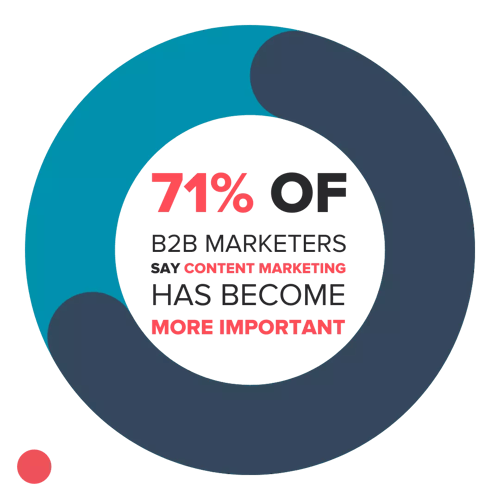
Further CMI research reveals that content marketing generates over three times as many leads as Outbound Marketing and costs 62% less; generates three times as many leads as paid search marketing per dollar spent, and small businesses with blogs get 126% more lead growth than small businesses that don't!
This shows that content marketing is an effective way to promote a business and reach potential customers. Creating engaging content that can be shared on various digital platforms can expand a company's reach by providing them with valuable resources that will meet the needs of their target audience.
When done well, content marketing will drive more traffic to a website and increase page views from prospective leads in an untargeted manner.
To ensure success with content marketing, research and understanding of the target audience is paramount. Companies need to understand what language works with their particular subject area, as well as what type of topics will resonate with their reader base.
Additionally, earn potential leads' trust by providing high-quality work - showcase expertise by sharing educational articles or eye-catching visuals that appeal directly to different audiences.
3. Marketing automation
To be successful at digital marketing, you need to be able to scale and automate your efforts. The digital marketing sphere continues to grow and new marketing channels are added to the mix monthly. It's highly impractical for any marketing agency to manage every marketing activity manually as some simply take too much time.
Lead engagement, for example, is one of the major time consumers for marketers and salespeople. Fortunately, this process can be intelligently automated by the marketing automation systems that exist today.
The advantage of using some form of marketing automation for lead management is that it will never forget to keep in touch with contacts or to move them to the right salesperson when they meet lead qualification criteria.
In addition, a challenge that many marketing agencies have is not just generating leads – but also nurturing those leads to a point where they are ready to buy. Using marketing automation you can develop workflows that send leads content or timely interactions to provide value based on how they interact with your website and content.
Using marketing automation it becomes possible for a small marketing team of two or three to operate in the same fashion as a large business, as well as generate qualified leads in the process.
4. Social media marketing
Don't underestimate the power of social media. Channels like Twitter, LinkedIn, Facebook, Instagram and even TikTok are being used by many B2B companies to generate qualified leads, as well as establish a community of people interested in what they do.
According to HubSpot's State of Marketing 2023 report, Facebook was still the most leveraged social media platform in 2022, used by 64% of marketers, followed by Instagram (58%), YouTube (57%), Twitter (43%), TikTok (42%), and LinkedIn (33%).
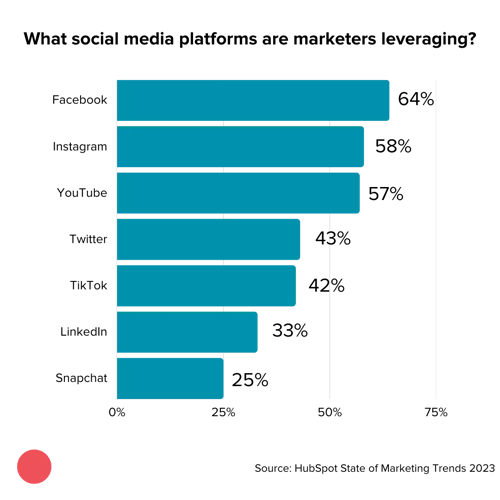
Image source: HubSpot's State of Marketing 2023 report
However, professional channels – particularly LinkedIn – provide a great platform for businesses to promote their content (especially gated content) to a wider audience. Most social media channels are free so all it requires is a little time and effort.
Furthermore, unlike other methods of marketing, social media allows for two-way conversation, a conversation that is far more natural and personal. Ensure you optimise your social media profiles for website lead generation (include a link to your website, a relevant content offer and other ways to get in touch) and be active on the platform!
In terms of content distribution, you should always be trying to provide value to your following – this means less about you and more about the things your audience is interested in and needs help with.
Over time, as you grow your following and drive people back to your website using content promoted on social media channels, you will generate qualified leads – people interested in what you do.
5. Lead flows
As a HubSpot user, we have access to what is called ‘Lead flows'. Unlike pop-ups that distract you the moment you connect to a website, however, lead flows can be configured to show up after a certain condition has been met or after a specified duration of time, ensuring that the user experience is not interrupted.
In essence, we use lead flows to move website visitors further into the buyer's journey without interrupting their experience.
If a website visitor is reading a page on B2B website lead generation strategies, for example, we could set up a lead flow to advertise an eBook called ‘Developing a lead-generating website in 2018' after the visitor reaches the middle of the page.
Using such an approach, we can engage with leads that would have otherwise left our website without converting. It's easy to implement and can increase the number of leads you generate considerably.
6. Chatbots
Modern customers – your prospects – want answers and they wanted them yesterday. The quicker a business can supply an answer to a question, the greater the sentiment a customer has for that business.
The Internet has made it incredibly easy for customers to find the information they want when they want it – and that puts a massive onus on businesses, i.e. you, to deliver the answers they want at the right time.
Of course, for some businesses, particularly small and medium-sized businesses (SMBs), responding to customer queries in real time can be difficult without a dedicated customer service team. Large business enterprises have no problem; someone on the customer service desk is there 24/7 to answer any potential questions.
However, failing to respond to a customer enquiry in a timely fashion could result in a lost sales opportunity, so SMBs need to have tools in place to streamline the communication process and make it easy for website visitors to self-educate.
So, one thing that many B2B websites are implementing to help with this is a chatbot. It's all about convenience and providing a service as and when the customer needs it.
Through chatbots and real-time chat, B2B companies can connect with customers at their point of need and provide them with the information they need to make informed purchase decisions.
As a result of such solutions, SMBs can scale their operations and engage with more and more prospects on a routine basis – something that was previously unmanageable.
Chatbots allow businesses to retain website visitors and nurture leads through the delivery of information on time, allowing salespeople to focus on what they do best: selling and getting in touch with leads when they show the symptoms of being ready to talk.
Marketing is always changing and for you to be successful at it you need to be employing the latest website lead generation strategies. If you want help generating more qualified leads for your business, please get in touch to find out how we can help you.
7. Live video
Live video is an increasingly popular form of digital marketing and with good reason. Data from Wyzowl reveals that a huge 91% of businesses are using video as a tool to boost their marketing presence.
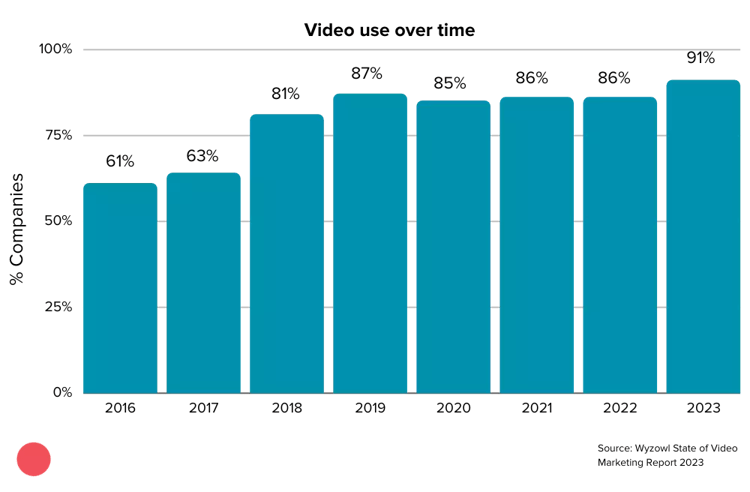
Image source: Wyzowl
Generating leads in this way is highly effective for businesses, and several different topics can be used in creating successful live video campaigns. Such topics include webinars, product launches, Q&As, teasers, how-tos, events and special guests.
At the same time, it's also possible to stream across multiple platforms such as LinkedIn, YouTube and/or Facebook via cloud multistreaming services along with specialised analytics packages which provide insights into each audience demographic associated with each platform.
8. Use sales intelligence
Sales intelligence is a powerful and invaluable asset for any business engaging in B2B lead generation strategies. By leveraging sales intelligence tools, you can build comprehensive lists of prospects in your target accounts with incredible accuracy.
Sales intelligence technology continuously mines the web for publicly available data which can be used to gain invaluable insights about decision-makers within and outside of these target accounts.
The process of gathering relevant B2B data is fast, efficient, and immensely more effective than relying solely on manual search techniques.
You will get far more accurate results from sales intelligence than traditional list building which requires manual research effort. With the right technology backing up your efforts, you’ll discover new opportunities quickly while confidently making decisions in the face of ever-evolving market trends.
9. Use case studies
Case studies are an invaluable asset to have in your content marketing library. Not only do they lend credibility and add to your website's landscape, but B2B buyers rely on them to make their decision of what to purchase.
For this reason, it is essential that you not merely let case studies sit idle on your site; instead, you must actively promote them if you wish to increase the chances of conversions.
When the analytical and risk-averse B2B buyer checks out a case study, they may decide that's just what they need for their business process or product – but it must be visible to them!
Shamelessly promote your case studies regardless of whether it’s through digital ads or printed material. This helps you provide the ROI-savvy decision makers with approval by equipping them with information about how it can improve sales figures or improve customer service standards.
Don't forget that launching promotions across social media channels such as Facebook or Twitter also boosts recognition of these powerful pieces of content marketing.
Taking the time to effectively promote a well-written and interesting case study will yield dividends for your business in no time at all, so don’t miss out on this amazing opportunity!
10. Publish original research
Publishing original research is a highly effective strategy for generating B2B leads. Original research, when conducted and presented correctly, can significantly enhance your organization's credibility, showcase your expertise, and provide valuable insights to your prospects.
When you publish original research, you're offering something unique - data and insights that aren't available anywhere else. This can make your content highly valuable to other businesses in your industry, who may use your research to inform their strategies or decision-making processes. According to Demand Gen Report, B2B buyers selected research/survey reports as the most valuable content source.
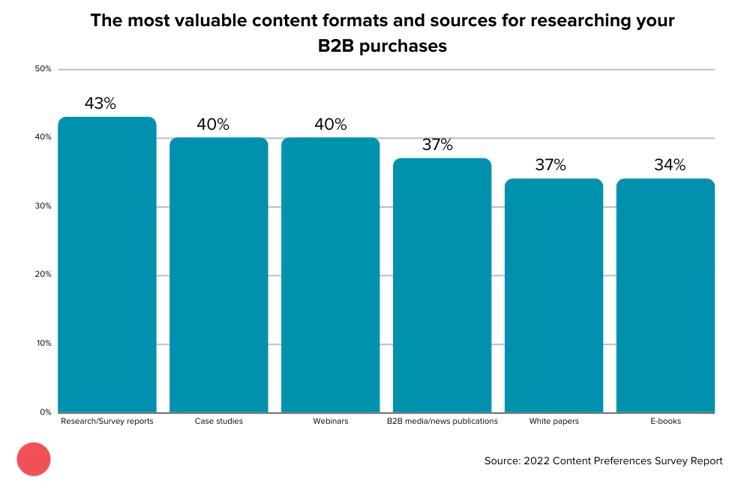
Image source: Demand Gen Report
Original research can also help you attract more website traffic. As reported by Jones PR, 74% of marketers cite increased website traffic as one of the benefits of using research as the basis for B2B marketing content. More website traffic can lead to more potential leads, as visitors to your site may become interested in your products or services after reading your research.
In addition, publishing original research can also boost your B2B lead generation efforts by enhancing your reputation as an industry expert. By providing new, insightful data, you demonstrate your organization's expertise and thought leadership. This can build trust with potential leads, making them more likely to consider doing business with you.
However, it's important to remember that the quality of your research is crucial. Your research needs to be accurate, relevant, and well-presented to effectively attract and engage potential leads. High-quality research reflects positively on your organization, reinforcing your credibility and boosting your lead-generation efforts.
11. Leverage influencer marketing
Leveraging influencer marketing can be a powerful strategy for B2B lead generation. Influencers, with their established credibility and large follower base, can significantly boost your brand's visibility and reputation in your industry.
When you collaborate with influencers, you get to tap into their audience - a group of potential leads who already trust and respect the influencer's opinion. According to a survey by Tomoson, businesses are making $6.50 for every $1 spent on influencer marketing. This shows the potential return on investment that influencer marketing can provide.
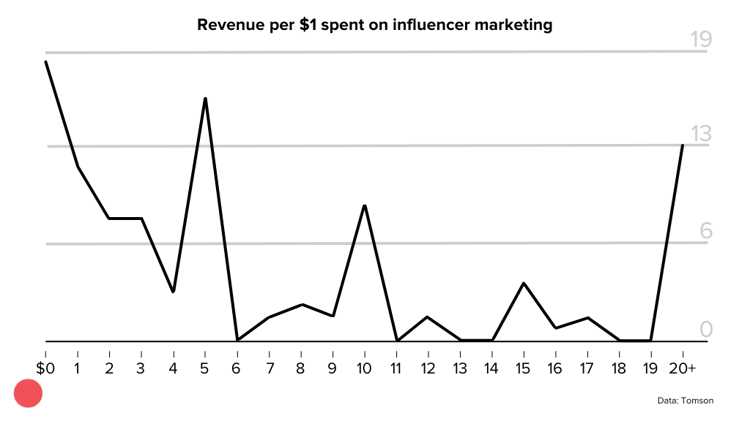
Image source: Tomson
Influencer marketing also allows you to present your business more authentically and engagingly. Instead of directly promoting your products or services, influencers can showcase how they're using your offerings in real-life situations, which can be more persuasive and relatable to potential leads.
Moreover, influencers can help you create more diverse and engaging content. They can share your content in unique ways, such as through video tutorials, live Q&A sessions, webinars, or social media takeovers. This can attract more attention and engagement from potential leads, boosting your lead generation efforts.
In addition, influencer marketing can enhance your SEO efforts. When influencers link to your website in their content, it can improve your search engine rankings, leading to more website traffic and potential leads.
However, it's crucial to choose the right influencers to collaborate with. They should be relevant to your industry, share similar values with your business, and have a genuine connection with their followers.
12. Capture new leads with webinars
Webinars can be an integral strategy for capturing new B2B leads. Webinars provide an opportunity to showcase your organisation's expertise, engage with potential leads in real time, and provide valuable information that can help solve their problems or meet their needs.
Webinars allow you to reach a wide audience and interact directly with them, answering their questions and addressing their concerns. According to ON24, 76% of marketers say webinars allow them to drive more leads. This is because webinars give you the chance to present detailed and comprehensive information about your products or services, establishing your organisation as a thought leader in your industry.
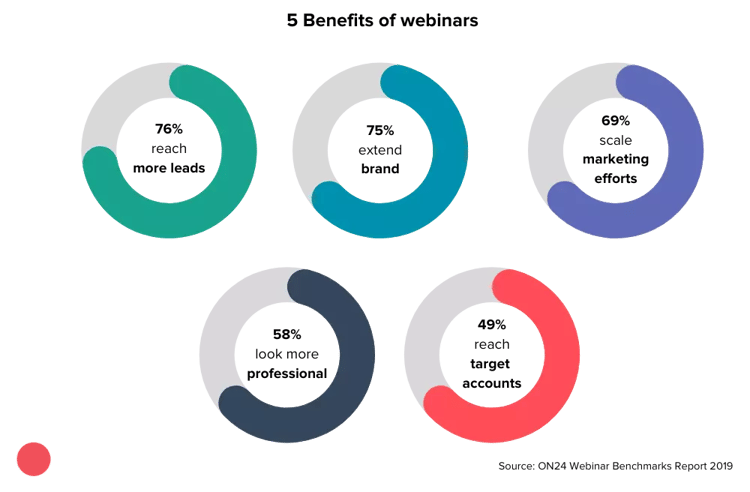
In addition to presenting valuable content, webinars also provide an opportunity to capture lead information. When attendees register for your webinar, you can ask for their contact details and other relevant information. This can help you build a database of potential leads who have already shown interest in what your organisation has to offer.
Additionally, webinars are a cost-effective lead-generation strategy. Unlike physical events, webinars don't require a large budget for venues, travel, or hospitality. They can be hosted virtually, allowing you to reach potential leads from all over the world.
Finally, webinars can be recorded and repurposed into other types of content, such as blog posts, social media snippets, or downloadable resources. This can extend the lifespan of your webinar content, attracting more leads even after the live event has ended.
But remember that it's important to ensure that your webinar is well-structured, engaging, and provides value to its attendees. A poorly executed webinar could harm your organisation's reputation instead of enhancing it.
13. Build trust with social proof
Building trust with social proof is an effective strategy for generating B2B leads. Testimonials, reviews, case studies, and endorsements from satisfied customers or respected industry figures can significantly enhance your organisation's credibility and persuade potential leads that your offerings are worth considering.
Social proof works on the principle that people are more likely to trust a product or service if they see that others have had a positive experience with it.
According to a study by Spiegel Research Center, nearly 95% of shoppers read online reviews before making a purchase. In the B2B context, this could translate to businesses looking for testimonials or case studies before deciding to engage with a vendor.
Featuring testimonials or reviews on your website can provide real-world evidence of the value of your products or services. These firsthand accounts can be more persuasive than any marketing copy, as they come directly from customers who have experienced the benefits of your offerings.
However, it's crucial to ensure that your social proof is genuine and relevant. Potential leads will likely be able to tell if your testimonials or endorsements are fabricated or irrelevant to their needs.
14. Build a free tool to generate B2B sales leads
A free tool that provides value to your target audience can attract potential leads to your business, engage them with your brand, and encourage them to explore your paid offerings.
A free tool can be anything that helps your target audience solve a problem or achieve a goal more efficiently. This could be a simple calculator, a template, a checklist, or even a more complex software application. The key is to ensure that the tool is genuinely helpful and relevant to your audience's needs.
By offering a free tool, you can demonstrate the value that your business can provide without asking for anything in return. This can build trust with potential leads and increase their likelihood of considering your paid offerings.
In addition to attracting potential leads, a free tool can also help you capture lead information. You can ask users to provide their contact details to access the tool, which can help you build a database of potential leads who have shown interest in your business.
Finally, a free tool can enhance your brand visibility and reputation. If your tool is truly valuable, users may share it with others in their network, leading to more potential leads discovering your business.
How Huble can help you generate more B2B leads
Generating high-quality B2B leads is an essential part of achieving business growth and success. Strategies such as creating valuable content, leveraging SEO, organising webinars, building trust with social proof, and developing free tools can play a significant role in attracting and engaging potential leads.
However, developing and implementing these strategies effectively can be challenging without the right expertise and resources. That's where our team at Huble can help. As a marketing consultancy service, we specialise in helping businesses like yours develop and execute powerful B2B lead generation strategies.
With our deep understanding of B2B marketing dynamics and our proven track record of delivering results, we can guide you in creating a lead generation strategy that aligns with your business goals and target audience needs.
So, if you're ready to generate more high-quality B2B leads and take your business growth to the next level, don't hesitate to speak with our team. Your journey towards better lead generation starts here.













.png)





